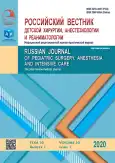Sacrococcygeal teratomas in newborns: peculiarities in diagnostics and treatment of small-sized tumors
- Authors: Gopienko M.A.1,2, Karavaeva S.A.1,2,3, Silkov V.B.3,4, Uskov O.I.2, Miagkova I.E.2, Belogurova M.B.4,5
-
Affiliations:
- Pavlov First St. Petersburg State Medical University
- Children’s City Multidisciplinary Clinical Specialized Center of High Medical Technologies
- North-Western State Medical University named after I.I. Mechnikov
- St. Petersburg State Pediatric Medical University
- St. Petersburg Clinical Scientific and Practical Center of Specialized Medical Assistance (Oncological)
- Issue: Vol 10, No 1 (2020)
- Pages: 43-52
- Section: Original Study Articles
- URL: https://journals.rcsi.science/2219-4061/article/view/123466
- DOI: https://doi.org/10.17816/psaic605
- ID: 123466
Cite item
Full Text
Abstract
Introduction. When revealing a sacrococcygeal tumor in pediatric patient (especially — newborn), a germ-cell tumor (GCT) (mostly — teratoma) should be suspected. Just observation in cases of such tumors of small size, which might look as an option, cannot be recommended.
Aim of study: to reveal the peculiarities of diagnostics and treatment of small-sized sacrococcygeal GCT in newborns.
Materials and methods. We analyzed the data of charts of patients with sacrococcygeal GCT from 2 clinics of St. Petersburg (pediatric surgical hospital CCMCSCHMT and pediatric oncological department of St. Petersburg Oncocenter) for past 15 years (2005–2019). Among 55 newborn patients the size of tumor varied, comprising 14 giant (over 14 cm in diameter), 18 large (10–14 сm in diameter), 21 medium-sized (3–9 cm), and 2 small-sized teratomas (under 3 cm in diameter).
Results. In both cases of small-sized GCT prenatal ultrasound was unable to reveal the tumor. Those patients appeared by surgeon occasionally (being either not transferred to hospital from the delivery house after birth or coming because of some other reason). Both patients underwent radical surgery with excision of coccyx (histological diagnosis being ‘mature teratoma’) and are still under observation of oncologist (with no signs of relapse during 6 months and 21 months). During the same period (2005–2019) there were 5 girls treated in St. Petersburg Oncocenter, with sacrococcygeal GCT first diagnosed at older age (10 months – 2 years 9 months). They all had less favorite course and prognosis (histologic variants being yolk sac tumor or embryonic carcinoma; having remote metastases in 2 cases, with relapse in 1 case, and lethal outcomes in 2 cases).
Conclusion. Small-sized sacrococcygeal GCT in newborns can bear a significant risk of delayed diagnosis with possible further malignization and formation of metastases, so active revealing and active surgical treatment in such cases is needed.
Keywords
Full Text
##article.viewOnOriginalSite##About the authors
Mikhail A. Gopienko
Pavlov First St. Petersburg State Medical University; Children’s City Multidisciplinary Clinical Specialized Center of High Medical Technologies
Author for correspondence.
Email: gopienkoma@mail.ru
assistant professor of the department of pediatric surgery with course of anesthesiology and intensive care; pediatric surgeon
Russian Federation, Saint PetersburgSvetlana A. Karavaeva
Pavlov First St. Petersburg State Medical University; Children’s City Multidisciplinary Clinical Specialized Center of High Medical Technologies; North-Western State Medical University named after I.I. Mechnikov
Email: svetlana.karavaeva@szgmu.ru
Dr. Sci. (Med.), Professor of the department of pediatric surgery with course of anesthesiology and intensive care; pediatric surgeon; Head of the department of pediatric surgery
Russian Federation, Saint PetersburgViacheslav B. Silkov
North-Western State Medical University named after I.I. Mechnikov; St. Petersburg State Pediatric Medical University
Email: silkucci@mail.ru
Cand. Sci. (Med.), associate professor of the department of oncology, pediatric oncology, and radiotherapy; pediatric surgeon-oncologist of the department of chemotherapy and combined treatment of tumors in children
Russian Federation, Saint PetersburgOleg I. Uskov
Children’s City Multidisciplinary Clinical Specialized Center of High Medical Technologies
Email: morphologdgb1@mail.ru
Head of pathology department
Russian Federation, Saint PetersburgIrina E. Miagkova
Children’s City Multidisciplinary Clinical Specialized Center of High Medical Technologies
Email: morphologdgb1@mail.ru
pediatric pathologist of pathology department
Russian Federation, Saint PetersburgMargarita B. Belogurova
St. Petersburg State Pediatric Medical University; St. Petersburg Clinical Scientific and Practical Center of Specialized Medical Assistance (Oncological)
Email: deton.hospital31@inbox.ru
Dr. Sci. (Med.), Professor, Head of the department of oncology, pediatric oncology, and radiotherapy; chief of the department of chemotherapy and combined treatment of tumors in children
Russian Federation, Saint PetersburgReferences
- The Human Teratomas, Experimental and Clinical Biology. Damjanov I, Knowles BB, Solter D, editors. Clifton, New Jersey: The Humana Press Inc.; 1983. 358 p.
- Göbel U, Schneider DT, Calaminus G, et al. Germ-cell tumors in childhood and adolescence. GPOH MAKEI and the MAHO study groups. Ann Oncol. 2000;11:263-271. https://doi.org/10.1023/a: 1008360523160.
- Altman RP, Randolph JG, Lilly JR. Sacrococcygeal teratoma: American Academy of Pediatrics Surgical Section survey-1973. J Pediatr Surg. 1974;9:389-398. https://doi.org/10.1016/s0022-3468(74)80297-6.
- Grosfeld JL, Ballantine TMN, Lowe D, Baechner RL. Benign and malignant teratomas in children: analysis of 85 patients. Surg. 1976;80:297-305.
- Мушинская М.В., Рыскаль О.В., Силков В.Б., и др. Случай рецидива врожденной тератомы крестцово-копчиковой области в виде опухоли желточного мешка // Вопросы гематологии/онкологии и иммунопатологии в педиатрии. — 2012. — Т. 11. — № 4. — С. 34–40. [Mushinskaya MV, Ryskal OV, Silkov VB, et al. Relapse of congenital sacrococcygeal teratoma in the form of yolk sac tumor: A case report. Problems of hematology/oncology and immunopathology in pediatrics. 2012;11(4):34-40 (In Russ.)]
- Göbel U, Calaminus G, Engert J, et al. Teratomas in infancy and childhood. Med Pediatr Oncol. 1998;31(1):8-15. https://doi.org/10.1002/(sici)1096-911x(199807)31:1<8::aid-mpo2>3.0.co;2-h.
- Yoshida M, Matsuoka K, Nakazawa A, et al. Sacrococcygeal yolk sac tumor developing after teratoma: A clinicopathological study of pediatric sacrococcygeal germ cell tumors and a proposal of the pathogenesis of sacrococcygeal yolk sac tumors. J Pediatr Surg. 2013;48(4):776-781. https://doi.org/10.1016/j.jpedsurg.2012.08.028.
Supplementary files










